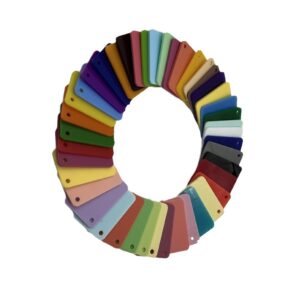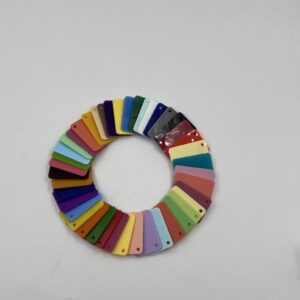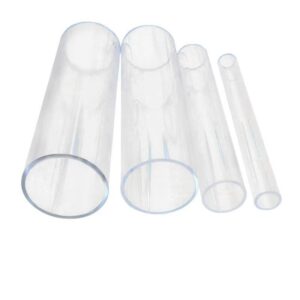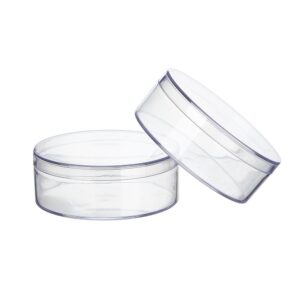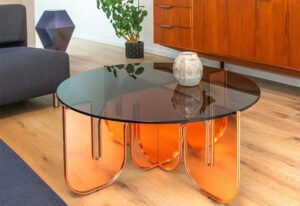Summary
Acrylic jewelry holders are storage solutions crafted from acrylic, a lightweight and durable thermoplastic that provides an elegant means to organize and display jewelry. Gaining popularity since the mid-20th century, these holders have become a staple in both budget and luxury markets, appealing to consumers with their blend of functionality and aesthetic appeal. The clear nature of acrylic allows for an unobstructed view of jewelry collections, while its versatility accommodates various designs, making it a preferred choice for personal use, retail displays, and event settings.
Table of Contents
The rise of acrylic jewelry holders can be attributed to growing consumer trends towards minimalism and organization, along with the increasing demand for stylish home decor items. By the late 20th century, these holders had secured their place in the market, with luxury brands incorporating acrylic into their product lines to cater to affluent buyers seeking high-end storage solutions. However, as environmental concerns around plastic usage have escalated in the 21st century, the jewelry industry has faced scrutiny regarding the sustainability of acrylic products, prompting manufacturers to explore eco-friendly practices, such as using recycled materials and reducing waste in production.
Acrylic jewelry holders are available in various forms, including display stands, necklace organizers, and customizable options that allow consumers to tailor their jewelry storage to individual preferences. The benefits of acrylic, including its durability, lightweight nature, and cost-effectiveness, further enhance its appeal, making it a go-to choice for consumers looking for reliable and stylish organization solutions. Despite the advantages, the reliance on acrylic raises ongoing debates about environmental impact and the need for sustainable alternatives in jewelry storage manufacturing.

History
Current Trends
Today, acrylic jewelry holders continue to be a staple in both the luxury and budget markets, reflecting ongoing trends toward personalization and sustainability. The combination of functionality, versatility, and style ensures that acrylic remains a popular choice for consumers looking to organize and display their jewelry collections. As the market evolves, the future of acrylic jewelry holders is expected to be shaped by technological advancements and a continued emphasis on eco-conscious manufacturing practices.
Development of Acrylic Jewelry Holders
The evolution of jewelry storage solutions has seen a significant shift towards the use of acrylic materials, primarily due to their aesthetic appeal and functional benefits. Acrylic, a versatile polymer, gained prominence in the mid-20th century when advancements in materials science allowed for the production of high-quality, durable plastics. These developments paralleled the growing demand for stylish and practical home decor items, including jewelry organizers.
Rise in Popularity
By the late 20th century, acrylic jewelry holders became increasingly favored among consumers. The clear nature of acrylic provides an elegant display for jewelry while simultaneously protecting it from dust and damage. This trend was amplified by a rising consumer interest in minimalism and organization, leading to the design of compact, space-saving organizers that align with contemporary decor preferences. Additionally, luxury brands began to adopt acrylic in their product lines, appealing to affluent buyers seeking high-end storage solutions that are both functional and aesthetically pleasing.
Sustainability Concerns
As awareness of environmental issues grew in the early 21st century, the jewelry industry began to face scrutiny regarding the materials used in products, including acrylic. Concerns regarding the sustainability of plastics, particularly in terms of their production and disposal, prompted a shift towards eco-friendly practices. This included the use of recycled materials and innovations in design that reduce waste. Many manufacturers are now exploring alternatives and mixed-material designs that incorporate sustainable practices while maintaining the visual appeal of acrylic products.
Types of Acrylic Jewelry Holders
Acrylic jewelry holders come in various designs and structures, each serving a distinct purpose in organizing and displaying jewelry. Their versatility and aesthetic appeal make them a popular choice among consumers, whether for personal use or retail environments.
Acrylic Necklace Holders
Acrylic necklace holders are designed specifically to showcase necklaces while keeping them organized. These holders are typically made from high-quality acrylic, offering a clear view of the jewelry and preventing tangling or damage. They often feature simple yet sturdy structural designs, ensuring durability and maintaining their shape over time.
Acrylic Display Stands
Acrylic display stands are versatile tools used to enhance the presentation of various jewelry types, including rings, bracelets, and earrings. These stands are available in multiple configurations, such as tiered designs that allow for the display of multiple pieces simultaneously. The crystal-clear visibility provided by acrylic makes it an excellent choice for highlighting intricate details of jewelry items.
Acrylic Jewelry Boxes
Acrylic jewelry boxes serve as storage solutions that combine organization with aesthetic appeal. These boxes often come with removable drawers and transparent panels, allowing users to easily access their jewelry while maintaining a tidy appearance. The lightweight nature of acrylic makes these boxes portable, making them ideal for travel or storage in limited spaces. Additionally, some designs may incorporate luxury features like LED lights to enhance the visual presentation of the jewelry stored inside.
Specialized Displays
In addition to general holders, there are specialized acrylic displays designed for specific types of jewelry. For instance, earring stands often have multiple slots or hooks to keep earrings organized and visible, while ring displays can feature padded sections to protect delicate pieces. The design flexibility of acrylic allows for innovative shapes and functions, catering to the unique preferences of different consumers.
Customizable Options
Many manufacturers offer customizable acrylic jewelry holders to meet specific needs, whether for retail settings or personal use. These custom options can include varying sizes, shapes, and finishes to enhance the overall aesthetic and functionality of the display. By tailoring these holders to individual preferences, users can create a personalized jewelry organization system that reflects their style.

Materials and Manufacturing
Sustainable Practices in Jewelry Manufacturing
The production of sustainable jewelry involves not only the selection of eco-friendly materials but also the implementation of responsible manufacturing processes. These processes aim to minimize waste, reduce energy consumption, and lower carbon footprints. For instance, the use of computer-aided design (CAD) technology helps jewelry makers minimize material waste during the design phase.
Recycling plays a crucial role in sustainable practices as well. Metals such as gold, silver, and platinum are often recycled by melting and reshaping them, thus reducing the need for mining activities that can harm the environment. Furthermore, packaging for jewelry should be sourced from recycled or biodegradable materials to further enhance sustainability by minimizing environmental impact.
Materials Used in Jewelry Boxes
Plastics and Acrylics
Jewelry boxes frequently utilize durable materials like plastics and acrylics, which are known for their strength and resilience. These materials not only protect jewelry from damage but also withstand environmental factors such as humidity and temperature fluctuations. Acrylic, in particular, is highly regarded for its impact resistance and aesthetic appeal, making it a preferred choice for display cases.
Acrylic, or polymethyl methacrylate (PMMA), is a transparent thermoplastic that serves as a lightweight alternative to glass. It is valued for its clarity and strength, offering several design possibilities while maintaining a classy appearance. Additionally, acrylic’s UV resistance and moldability allow for intricate designs that cater to varying consumer preferences.
Cost-Effectiveness and Availability
The widespread use of plastics and acrylics in jewelry box manufacturing can be attributed to their cost-effectiveness and availability. These materials can be mass-produced using techniques like injection molding, resulting in lower labor and production costs. Furthermore, their lightweight nature reduces shipping expenses, making them a practical choice for both small businesses and large manufacturers.
Environmental Considerations
Despite the benefits of plastics and acrylics, their environmental impact cannot be overlooked. The production of these materials typically involves non-renewable petrochemicals, which contribute to greenhouse gas emissions and environmental degradation. Additionally, many jewelry boxes are designed for single-use, leading to increased waste generation and further environmental concerns.
In response to these challenges, the jewelry industry is exploring ways to enhance sustainability by adopting more eco-friendly materials and manufacturing practices. By prioritizing durability and recyclability, manufacturers can create products that are not only functional but also environmentally responsible.

Benefits of Acrylic Jewelry Holders
Acrylic jewelry holders offer a range of advantages that make them a popular choice among consumers and manufacturers alike.
Aesthetic Appeal
Acrylic jewelry holders offer high transparency, which enhances the visual appeal of the jewelry displayed within. This feature allows the colors and designs of the jewelry to shine through, making it an attractive choice for showcasing valuable pieces. The modern and sleek look of acrylic complements contemporary interior designs, aligning well with the preferences of consumers who value both form and function.
Lightweight and Portable
One of the most significant benefits of acrylic jewelry holders is their lightweight nature. Compared to heavy glass alternatives, acrylic holders are easier to carry and handle, which reduces transportation costs during shipping and delivery. This portability makes them an ideal choice for consumers who prefer convenience when organizing and storing their jewelry.
Durability
Acrylic is known for its durability, being less prone to breaking than glass. This toughness means that acrylic jewelry holders can withstand accidental falls or impacts without compromising the protection of the jewelry inside. Additionally, acrylic possesses excellent anti-aging properties, which prevent deformation and discoloration over time, ensuring that the holders remain attractive and functional for years.
Cost-Effectiveness
The affordability of acrylic as a raw material allows manufacturers to produce jewelry holders at a competitive price point while maintaining high quality. The moderate pricing of acrylic not only helps keep production costs down but also provides consumers with cost-effective storage solutions that do not sacrifice aesthetics. Furthermore, the stability of acrylic materials minimizes processing losses, further enhancing overall cost-effectiveness for manufacturers.
Customization Options
Many manufacturers, such as Jayi, leverage advanced processing technologies to offer customized designs for acrylic jewelry holders. This ability to tailor products to specific customer needs provides a unique competitive advantage in the market. Consumers appreciate the option to personalize their jewelry storage solutions, making acrylic holders a versatile choice for different styles and preferences.

Comparisons with Other Materials
Material Variety in Jewelry Box Manufacturing
Jewelry boxes are manufactured using a diverse array of materials, each offering unique characteristics and benefits. Traditional materials include wood, leather, and glass, while modern designs often incorporate plastics, acrylics, and mixed materials to achieve both functionality and aesthetic appeal.
Advantages of Acrylic and Plastics
Acrylic, also known as Polymethyl Methacrylate (PMMA), stands out as a preferred choice in jewelry box design due to its lightweight nature and transparency, resembling glass but with enhanced durability. Unlike glass, acrylic is resistant to shattering, making it a safer option for jewelry storage, especially in households with children or pets. Its clarity allows for an attractive display of jewelry, elevating the aesthetic appeal of the storage solution.
Plastics, such as Polypropylene (PP) and Acrylonitrile Butadiene Styrene (ABS), are also commonly used due to their cost-effectiveness and durability. These materials are resistant to moisture and can be molded into intricate designs, making them ideal for creating detailed compartments and features within jewelry boxes. Furthermore, plastics can be manufactured more economically than traditional materials, allowing for lower retail prices, which is particularly advantageous in bulk markets like the U.S.
Mixed Material Designs
Combining acrylic or plastics with other materials, such as faux leather or wood, creates hybrid designs that leverage the strengths of each material. For instance, a plastic base wrapped in faux leather provides a luxurious appearance without sacrificing durability. Acrylic lids on wooden boxes not only enhance visibility but also add a modern touch to classic designs. These mixed material designs cater to varying customer preferences for both style and practicality.
Environmental Considerations
Despite the benefits, the use of plastics and acrylics in jewelry box manufacturing poses environmental challenges. These materials are derived from non-renewable petrochemicals and their production contributes to greenhouse gas emissions. Furthermore, many jewelry boxes are designed for single use, leading to waste issues due to their relatively short lifespan. On the other hand, sustainable alternatives like FSC-certified wood and bamboo are gaining popularity among environmentally-conscious consumers, offering an ethical option for those looking to minimize their carbon footprint.
Acrylic Tips
Select the right acrylic type and thickness, confirm digital proofs, choose polished or frosted edges, specify UV printing or LED integration, add precise drilling and mounting, and pack securely for safe delivery.
Usage
Acrylic jewelry holders serve multiple functions across various settings, reflecting their versatility and aesthetic appeal.
- Home Organization Acrylic holders are popular for personal use in home décor. They provide stylish solutions for organizing and displaying jewelry, helping to keep collections tidy and accessible. Their modern appearance enhances interior spaces, making them ideal for showcasing rings, earrings, and necklaces without creating clutter. Additionally, acrylic’s lightweight nature allows for easy relocation and rearrangement, accommodating different room styles and personal preferences.
- Retail Displays In retail environments, acrylic jewelry holders are vital for visual merchandising. They enhance the presentation of items, attracting customer attention and encouraging purchases. Retailers can use clear acrylic stands to highlight individual pieces or collections, creating a minimalist look that keeps the focus on the jewelry itself. Customizable options, such as backlighting or rotating displays, further enhance the shopping experience by making displays more engaging and interactive.
- Special Events Acrylic holders are also effective in event settings, such as weddings and exhibitions. They can be used to display table numbers, seating charts, or featured pieces of jewelry, adding an elegant touch to décor. Their transparent design ensures that the information remains clear and unobtrusive, enhancing the overall aesthetic of the event. Additionally, the reusability of acrylic stands makes them a cost-effective choice for multiple events.
- Museums and Galleries Acrylic holders play an essential role in museums and galleries by securely displaying delicate artifacts and providing information plaques without detracting from the art. Their transparent nature allows for unobstructed views, while providing protection against damage. This application highlights their importance in preserving and showcasing artistic and cultural heritage.
- E-commerce and Packaging With the rise of online shopping, acrylic holders are increasingly used in e-commerce settings to ensure safe and visually appealing packaging for jewelry. They help maintain the quality of products during shipping while presenting items attractively upon delivery. Additionally, the emphasis on sustainable practices has led to a demand for eco-friendly packaging solutions, including acrylic options that can be recycled or reused.
Design Trends
Aesthetic Innovations
Recent trends in acrylic jewelry holders emphasize minimalism, color integration, and thematic setups, which enhance product visibility and appeal. This modern aesthetic allows brands to provide a better product visualization, making items like jewelry look more appealing while building brand reputation. Clear acrylic designs are particularly favored, as they highlight the characteristics of precious items through simple and clean shapes.
Functional Design Features
In addition to aesthetics, the structural innovation of acrylic jewelry holders plays a significant role in their popularity. Designers focus on user convenience by implementing features such as organized compartments, hooks, and slots, making it easier for customers to browse and select pieces from a collection. Furthermore, some designs include locking mechanisms and soft linings to protect jewelry from damage and theft, enhancing the overall user experience.
Customization and Sustainability
The principle of customer-centeredness is also prevalent, as manufacturers like Jayiacrylic engage deeply with customers to create customized designs that reflect individual tastes and preferences. This level of personalization not only enhances the product’s quality but also fosters customer satisfaction and trust. Additionally, the use of recyclable materials aligns with the growing emphasis on environmental protection in design practices, showcasing a commitment to sustainability that resonates with modern consumers.
Global Influences
Design trends vary across different markets. For instance, the French market shows a preference for elegant and ornamental jewelry organizers, while Japan leans towards innovative, space-effective solutions that cater to minimalist living. These cultural nuances influence the styles and functionalities that are popular, reflecting diverse consumer habits and preferences across the globe. As a result, brands can strategically tailor their designs to appeal to specific demographics and enhance market engagement.
Buying Guide
When selecting acrylic jewelry holders, consumers should consider various factors to ensure they choose the best option for their needs.
Price Range
Acrylic jewelry holders come at various price points, and it is essential to establish a budget before shopping. Offering price tiers can help cater to different consumer segments—from budget-friendly options to premium, designer holders. Look for occasional sales or promotions that could enhance your purchase value.
Material Quality
The durability and appearance of acrylic jewelry holders are heavily influenced by the material quality. High-quality acrylic is resistant to scratches and can maintain clarity over time, making it an ideal choice for showcasing jewelry. Look for holders that feature thick, robust acrylic to prevent warping or breaking.
Design and Functionality
Acrylic jewelry holders come in various designs, from compact organizers to more elaborate displays. Choose a design that complements your personal style and fits your space. For example, contemporary and minimalist styles are increasingly popular, as they allow jewelry to be integrated into household decor while keeping it organized and accessible. Additionally, consider whether the holder offers compartments or modular configurations that can be customized to accommodate different types of jewelry, such as rings, necklaces, and bracelets.
Size and Capacity
Evaluate the size and capacity of the acrylic jewelry holder to ensure it meets your storage needs. Some holders are designed to be space-saving, making them suitable for small areas or travel purposes, while others provide ample storage for larger collections. Ensure the dimensions align with the jewelry pieces you own and how you plan to use the holder.
Eco-Friendliness
Sustainability is becoming an essential consideration for many consumers. When choosing acrylic jewelry holders, look for products made from eco-friendly materials or those that emphasize recyclable packaging. Brands focusing on sustainability may also offer products made from biodegradable or recycled materials, catering to consumers’ growing environmental concerns.
Brand Reputation
Consider purchasing from established brands known for quality and craftsmanship. Research reviews and ratings to ensure the acrylic holder you are considering has a solid reputation for durability and customer satisfaction. While established brands may command a higher price, they often offer better quality and design.
Smart Features
Emerging trends in jewelry organization include smart features such as LED lighting or anti-tarnish technology. These innovations not only enhance the functionality of acrylic jewelry holders but also appeal to tech-savvy consumers. Consider if these features are essential to your shopping needs, as they can add both convenience and aesthetic appeal.
By keeping these considerations in mind, consumers can make informed decisions when purchasing acrylic jewelry holders that best suit their personal style and functional requirements.
Maintenance and Care
Proper maintenance and care of acrylic jewelry holders are essential to ensure their longevity and aesthetic appeal. Acrylic, known for its durability and resistance to breakage, requires minimal maintenance compared to other materials like glass or wood.
Cleaning Acrylic Jewelry Holders
To maintain the clarity and shine of acrylic holders, it is recommended to use a soft microfiber cloth for dusting. For deeper cleaning, gentle washing with mild soap and water or an acrylic-safe cleaner is advised. It is important to avoid using rough pads or cleaners containing ammonia, as these can scratch or damage the acrylic surface. For small scratches, acrylic polish can be applied to restore the smooth finish.
Preventing Damage
While acrylic is robust and shock-absorbent, it is still crucial to avoid exposing it to extreme conditions. Acrylic holders are resistant to high and low temperatures, making them suitable for various environments; however, care should be taken to prevent exposure to direct sunlight for extended periods, which could lead to fading or yellowing over time.
Additionally, adding soft linings or foam inside the box can protect jewelry from scratches and absorb any moisture, further safeguarding the items stored within.
Long-Term Care
For long-term storage, acrylic holders are an excellent choice as they prevent tangling and damage, keeping jewelry organized and easily accessible. Their lightweight nature makes them portable, which is beneficial for travel. Regularly checking for any signs of wear or damage will help ensure that the acrylic jewelry holders remain in good condition, extending their lifespan and maintaining their functionality and appearance.





